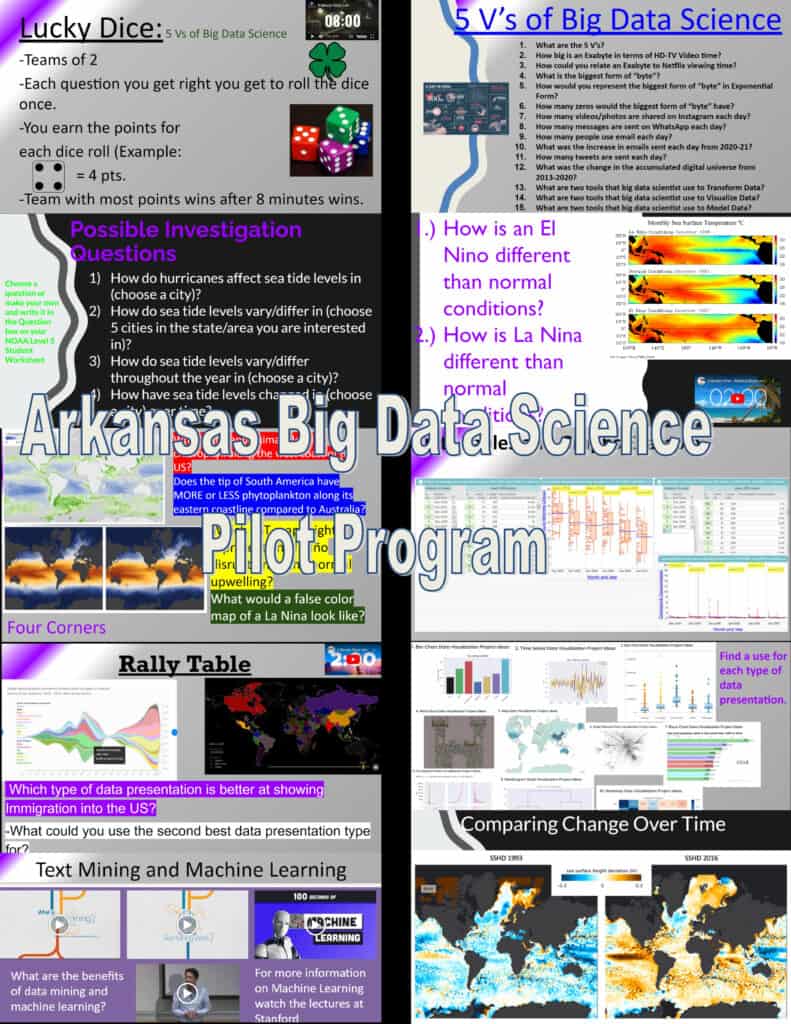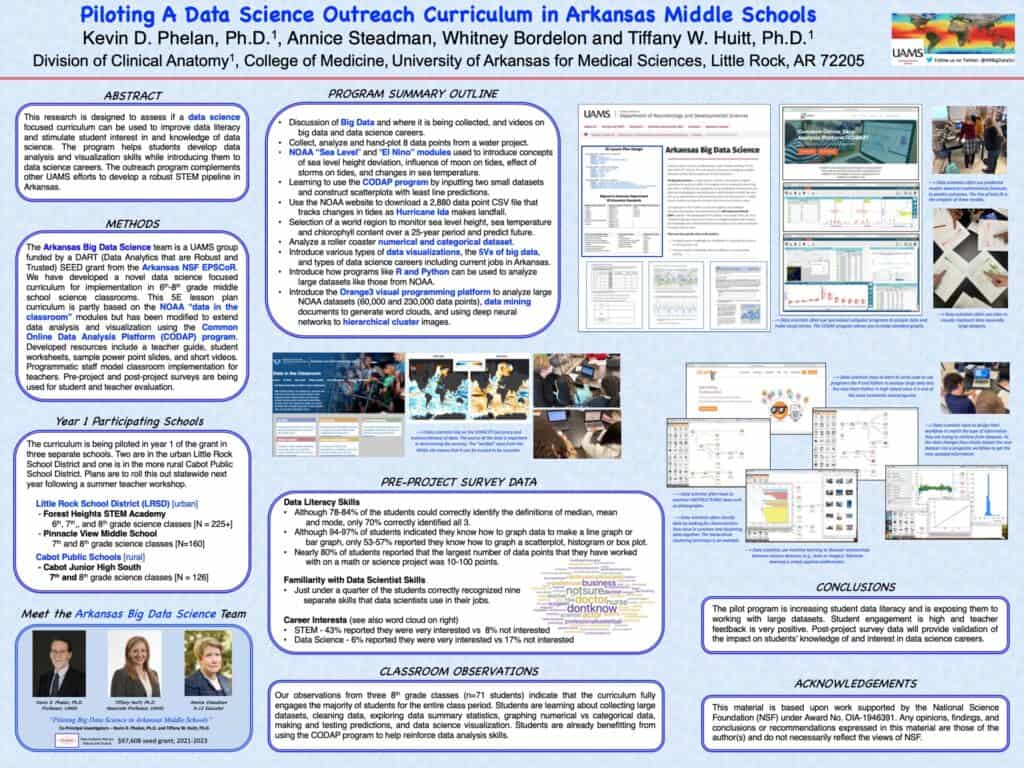AR Big Data Science is a data science outreach and research program sponsored by faculty at UAMS. This program will be piloting the use of big data sets in middle school classrooms using established modules from the National Oceanographic and Atmospheric Administration (NOAA). We view this as an opportunity to stimulate enthusiasm for data science in middle school students so they will consider data science as a future career.
Our approach in the middle schools will augment the statewide educational ecosystem being fostered by the NSF Arkansas EPSCoR DART program. The overall goal of this project is to assess if the use of an integrated big data science curriculum can engage students and increase the knowledge and understanding of how big data can be used to interpret the world around them.
There are two specific aims to the project:
- Increase teacher knowledge and confidence in using big data science in the classroom and
- Increase student knowledge, skills and efficacy in using big data science.
Program Staff
- Kevin D. Phelan, Ph.D., Professor, Division of Clinical Anatomy, UAMS (Co-Director)
- Tiffany W. Huitt, Ph.D., Associate Professor, Division of Clinical Anatomy, UAMS (Co-Director)
- Annice Steadman, retired Arkansas educator (Curriculum Integration Coordinator)
Program Staff Bios
Annice Steadman
Having grown up on a west Arkansas farm afforded Annice Steadman the opportunity to begin her science education at an early age. The farm was a science laboratory offering lessons in agronomy, animal husbandry, environmental science, evolution, animal and plant behavior, and microbiology. With a degree in science education, she accepted her first teaching position at a middle school in the Little Rock School District teaching Earth, life, and physical science. Six years later, she accepted an invitation to teach biology and AP Biology at Little Rock Central High School. During her twelve-year tenure she became involved in preparing students for the science competitions. The Arkansas School for Mathematics, Sciences and the Arts employed Mrs. Steadman as the Director of Life Science. There she worked with an outstanding group of teachers to write the curriculum, design classrooms and laboratories, and recruit students for the charter class. For the next two years she taught AP Biology, microbiology, and anatomy and physiology while serving as Director of the ASMS Regional Science Fair. After returning to Central, she worked with College Board during the summer months as an APSI AP Biology instructor. After a career in public school she spent six years at Pulaski Academy Upper School. Retirement to help with grandchildren did not last long. Mrs. Steadman returned to LRSD for the next four years as the Science Lead Teacher.
Funding Announcement
The AR Big Data Science team is excited to announce that we have just been awarded an NSF Arkansas EPSCoR DART Seed Grant. This is a two-year $98,000 grant supported by the National Science Foundation under Award No. OIA-1946391. The title of the grant is: “Piloting Big Data Science in Arkansas Middle Schools.”
Any opinions, findings, and conclusions or recommendations expressed in this material are those of the author(s) and do not necessarily reflect the views of the National Science Foundation.
Social Media
Follow us on Twitter at ARBigDataSci and Instagram at arbigdatasci.
Middle School Teachers Across the State
If you are a middle school teacher in Arkansas and you would like to participate in our pilot program this year, please contact us via email at Arbigdatascience@gmail.com.
Middle School Teacher Testimonials – Year 1: Forest Height Stem Academy, Pinnacle View Middle School, and Cabot Junior High South
Middle School Teacher Testimonials – Year 2: Vilonia Middle School and Oakdale Middle School in Rogers
The figure below shows examples of some daily slides as adapted from our curriculum by Joshua Rodriguez who is an 8th grade teacher at Oakdale Middle School in Rogers. His five science classes ran through our pilot curriculum this Spring (see testimonial 2 above).

Research Presentation Poster
Click the image to see it larger.
Text from Poster Image
Abstract
This research is designed to assess if a data science focused curriculum can be used to improve data literacy and stimulate student interest in and knowledge of data science. The program helps students develop data analysis and visualization skills while introducing them to data science careers. The outreach program complements other UAMS efforts to develop a robust STEM pipeline in Arkansas.
Methods
The Arkansas Big Data Science team is a UAMS group funded by a DART (Data Analytics that are Robust and Trusted) SEED grant from the Arkansas NSF EPSCoR. We have developed a novel data science focused curriculum for implementation in 6th-8th grade middle school science classrooms. This 5E lesson plan curriculum is partly based on the NOAA “data in the classroom”modules but has been modified to extend data analysis and visualization using the Common Online Data Analysis Platform (CODAP) program. Developed resources include a teacher guide, student worksheets, sample power point slides, and short videos. Programmatic staff model classroom implementation for teachers. Pre-project and post-project surveys are being used for student and teacher evaluation.
Program Summary Outline
- Discussion of Big Data and where it is being collected, and videos on big data and data science careers.big data and data science careers.
- Collect, analyze and hand-plot 8 data points from a water project.•NOAA “Sea Level” and “El Nino” modules used to introduce concepts of sea level height deviation, influence of moon on tides, effect of storms on tides, and changes in sea temperature.
- Learning to use the CODAP program by inputting two small datasets and construct scatterplots with least line predictions.•Use the NOAA website to download a 2,880 data point CSV file that tracks changes in tides as Hurricane Ida makes landfall.
- Selection of a world region to monitor sea level height, sea temperature and chlorophyll content over a 25-year period and predict future.
- Analyze a roller coaster numerical and categorical dataset.•Introduce various types of data visualizations, the 5Vs of big data, and types of data science careers including current jobs in Arkansas.•Introduce how programs like R and Python can be used to analyze large datasets like those from NOAA.•Introduce the Orange3 visual programming platform to analyze large NOAA datasets (60,000 and 230,000 data points), data mining documents to generate word clouds, and using deep neural networks to hierarchical cluster images.
Pre-Project Survey Data
Data Literacy Skills
- Although 78-84% of the students could correctly identify the definitions of median, mean and mode, only 70% correctly identified all 3.
- Although 94-97% of students indicated they know how to graph data to make a line graph or bar graph, only 53-57% reported they know how to graph a scatterplot, histogram or box plot.
- Nearly 80% of students reported that the largest number of data points that they have worked with on a math or science project was 10-100 points.
Familiarity with Data Scientist Skills
- Just under a quarter of the students correctly recognized nine separate skills that data scientists use in their jobs.
Career Interests
- STEM – 43% reported they were very interested vs 8% not interested
- Data Science – 6% reported they were very interested vs 17% not interested
Classroom Observations
Our observations from three 8th grade classes (n=71 students) indicate that the curriculum fully engages the majority of students for the entire class period. Students are learning about collecting large datasets, cleaning data, exploring data summary statistics, graphing numerical vs categorical data, making and testing predictions, and data science visualization. Students are already benefitting from using the CODAP program to help reinforce data analysis skills.
Conclusions
The pilot program is increasing student data literacy and is exposing them to working with large datasets. Student engagement is high and teacher feedback is very positive. Post-project survey data will provide validation of the impact on students’ knowledge of and interest in data science careers.
Acknowledgements
This material is based upon work supported by the National Science Foundation (NSF) under Award No. OIA-1946391. Any opinions, findings, and conclusions or recommendations expressed in this material are those of the author(s) and do not necessarily reflect the views of NSF.

